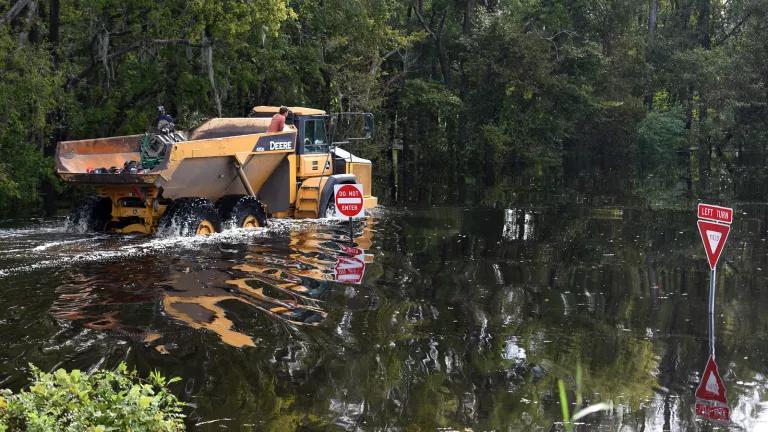NRDC Pushes FEMA for Climate-Smart Flood Maps and Standards
Given climate-fueled flooding disasters are happening at a frightening pace, FEMA must initiate reforms to the NFIP as soon as possible.

NRDC filed comments with FEMA (the Federal Emergency Management Agency) urging the agency to make critical climate-smart reforms to the National Flood Insurance Program. NRDC and the Association of State Floodplain Managers had petitioned FEMA to update its standards given the threats of climate change. FEMA’s call for public comment was in direct response to the petition. Given climate-fueled flooding disasters are happening at a frightening pace, FEMA must initiate reforms to the NFIP as soon as possible.
In our comments, NRDC requested FEMA:
(1) Use the Best Science Available to Protect Against Building in Flood-Prone Areas: FEMA, by law, must incorporate the best available science regarding sea levels, precipitation, and intensity of hurricanes in any revision or update of NFIP flood maps. FEMA must also include multiple projections of flood elevations as advisory layers on Flood Insurance Rate Maps so they can be used for planning purposes.
(2) Require Homes be Safer from Flooding: Require non-critical structures to be designed with a higher margin of safety against flooding. In A zones, FEMA should adopt a higher freeboard standard, requiring, at minimum, 2 feet of freeboard above the base flood elevation (BFE) for new construction and for substantial damage or improvements to existing structures. In V zones, FEMA should require a higher freeboard standard of 4 feet above the non-sea level rise adjusted BFE for new construction and for substantial damage or improvements to existing structures
(3) Protect Critical Infrastructure from Floods: Create a new standard for critical facilities and infrastructure. FEMA should:
- Prohibit new critical facilities/infrastructure, where feasible, from the 0.2 percent annual chance floodplain.
- If location outside of the 0.2 percent annual chance floodplain is not feasible, require redeveloped, substantially improved, or new critical facilities/infrastructure to be elevated to the 0.2 percent chance flood elevation, plus freeboard to account for future conditions, or the historical flood of record, whichever is greater.
(4) Expand Mitigation Support and Access to Buyouts for Repeatedly Flooded Properties: Increase the ICC payout from $30,000 to at least $60,000. Add a new optional ICC coverage option that goes up to at least $100,000. In addition, expand eligible activities to include buyouts of substantially damaged properties and other residential mitigation activities.
(5) Provide Prospective Home Buyers and Renters the Right to Know Their Flood Risk: As a condition of participation in the NFIP, states and communities should be required to enact disclosure laws that require home buyers and renters be told about a property’s history of flood damage and other flood risk information, prior to committing to buy or rent. Such a requirement should ensure that persons selling or renting a property disclose the following information:
- Whether the home has ever been damaged by a flood and the extent of the damage;
- Whether the home is in a floodplain and, if it is, the flood zone classification (100-year or 500-year) of the property and the source and date of this information; and
- Whether the seller and/or previous owners ever received federal disaster aid, which requires that all future owners obtain and maintain flood insurance on the property.
Fannie Mae also urged FEMA to require better flood-risk disclosure laws in comments the government sponsored mortgage company submitted last week.
Beyond these disclosure requirements, FEMA should provide current homeowners, with similar information. Currently, FEMA only provides such information after a person has purchased flood insurance through the NFIP. FEMA should also create a public, open-data system to share information related to a community or region’s flood risk, such as current and historical policy information, the total number of multiple-loss properties in a community, and whether a community was in compliance with the various standards they are responsible for enforcing.
(6) Prioritize equitable outcomes: FEMA must be vigilant in ensuring that floodplain management standards do not directly or inadvertently reinforce or exacerbate existing challenges with safe and affordable housing, displacement and gentrification. Further, our nation’s history of mortgage redlining and other forms of structural racism has left communities of color at higher risk of being exposed to flood risks and/or with less public investment in measures to protect against flooding. FEMA must direct robust resources and technical assistance for flood mitigation to disadvantaged and marginalized homeowners and communities in keeping with Justice40 commitments and through direct engagement with these communities.
Broad support exists to reform the outdated flood insurance program.
The Anthropocene Alliance (A2), a coalition of grassroots groups across 21 states and Puerto Rico, representing thousands of people who experience repeated flooding, storms, and other effects of climate change, submitted comments from 454 flood survivors. The comments call on FEMA to protect individuals and communities from present and future harms due to more intense storms, rising sea levels, subsidence, bad development, and flooding. In addition, dozens of individual A2 members have submitted comments and showed up to three public hearings to voice the need for reform.
Flooding is a significant and costly threat to life and property, and one of the most common natural hazards in the United States. Ongoing and future changes to the climate are increasing the likelihood for floods to cause displacement, injury and illness, loss of life, damage to homes, and the failure of critical infrastructure and the essential community services provided by such infrastructure. Meanwhile, our nation’s history of redlining, segregation, and other forms of structural racism and discrimination has left communities of color and other marginalized communities at higher risk of being exposed to flood risks. FEMA must act now to reform the NFIP.




